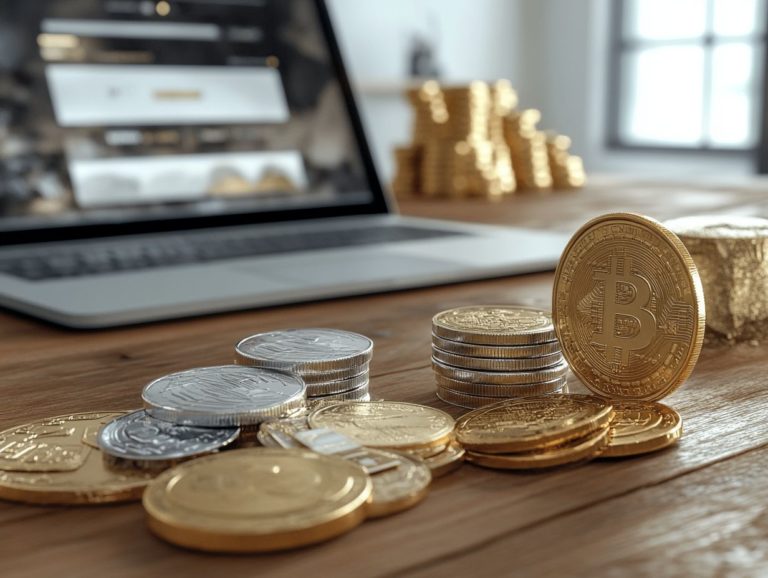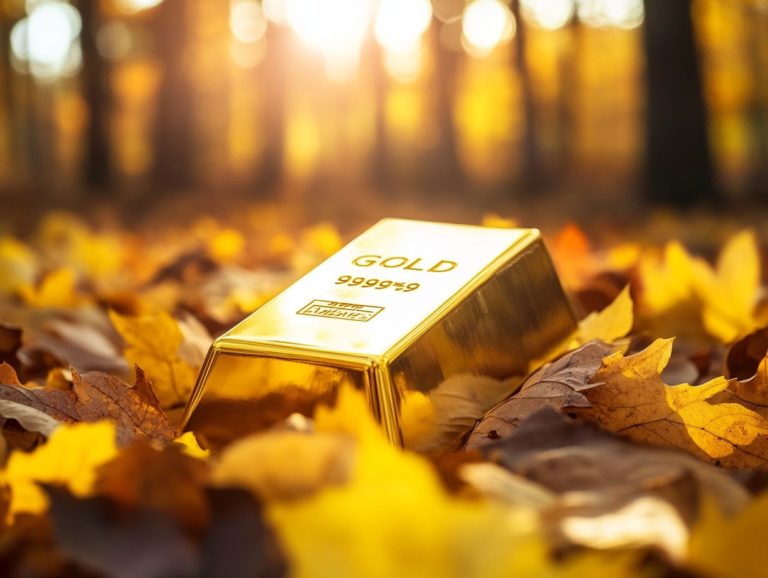Understanding Precious Metal Market Cycles
Navigating the world of precious metals can often feel like you’re standing on shifting sands. Market cycles play a crucial role in determining the value and demand for these valuable assets.
This article delves into what market cycles are and how they specifically impact precious metals. It explores the various factors that influence these cycles, identifies key indicators to watch, and discusses effective investment strategies.
Whether you re a seasoned investor or just starting your journey, understanding these dynamics can empower you to make informed decisions in this ever-evolving market.
Contents
- Key Takeaways:
- What are Market Cycles?
- Why are Precious Metals Affected?
- Factors Influencing Precious Metal Market Cycles
- Identifying Market Cycles
- Strategies for Investing in Precious Metals
- Predicting Future Market Cycles
- Frequently Asked Questions
- Curious about precious metal market cycles? Let s dive in!
- How can understanding precious metal market cycles benefit me?
- What are the different stages of a precious metal market cycle?
- What factors influence precious metal market cycles?
- How long do precious metal market cycles typically last?
- What can I do to stay updated on precious metal market cycles?
Key Takeaways:
- Precious metal market cycles are influenced by economic conditions, supply and demand, and investor sentiment.
- Key indicators such as interest rates and inflation can help identify market cycles.
- Investors can use strategies like long-term investing and technical analysis to take advantage of precious metal market cycles and predict future trends.
What are Market Cycles?
Market cycles are the periodic fluctuations in the economic landscape that directly affect commodity prices, especially precious metals like gold and silver.
Understanding these cycles is essential for making informed investment decisions, particularly during crucial moments like economic downturns marked by changing interest and inflation rates.
These cycles can significantly sway market sentiment, prompting you to reevaluate your strategies for diversifying your portfolio and managing risk.
Why are Precious Metals Affected?
Precious metals, such as gold and silver, are strongly affected by various market forces, particularly those from central banks, inflation rates, and economic downturns.
These factors can shift demand dynamics and impact market cycles, leading to price fluctuations that require careful navigation. Geopolitical events like trade tensions and political instability can inject uncertainty into the market, prompting investors to seek the relative safety of gold and silver.
For example, during recent trade disputes, gold prices soared as investors sought refuge from the storm of market volatility.
Expert analyses suggest that even a 1% increase in inflation can trigger a staggering 7% rise in gold demand, highlighting its role as a hedge against currency devaluation. Furthermore, industrial demand especially for silver in sectors like electronics and renewable energy adds yet another layer of complexity to the landscape.
Grasping these dynamics is vital for you as an investor aiming to optimize your portfolio effectively.
Factors Influencing Precious Metal Market Cycles
Several critical factors influence the market cycles of precious metals, including economic conditions, supply and demand dynamics, and investor sentiment regarding gold and silver.
These elements serve as the foundation of market indicators, helping you understand how these assets might perform across different scenarios.
Economic Conditions
Economic conditions are crucial in shaping market cycles, particularly through factors like interest and inflation rates that can trigger economic downturns. These variables dictate the investment landscape, influencing how you view the value of precious metals.
When central banks adjust interest rates to counter inflation or stimulate growth, your demand for gold and silver is likely to shift. For instance, during periods of high inflation, you might find yourself leaning towards precious metals as a hedge, which tends to push prices upward.
Historical trends show that during the 2008 financial crisis, gold prices surged as market confidence plummeted, reinforcing its reputation as a safe haven. Similarly, recent fluctuations in economic indicators, like GDP growth and employment rates, have significantly impacted market cycles.
This demonstrates how interconnected these factors are and how they shape your sentiment toward investing in precious metals.
Supply and Demand
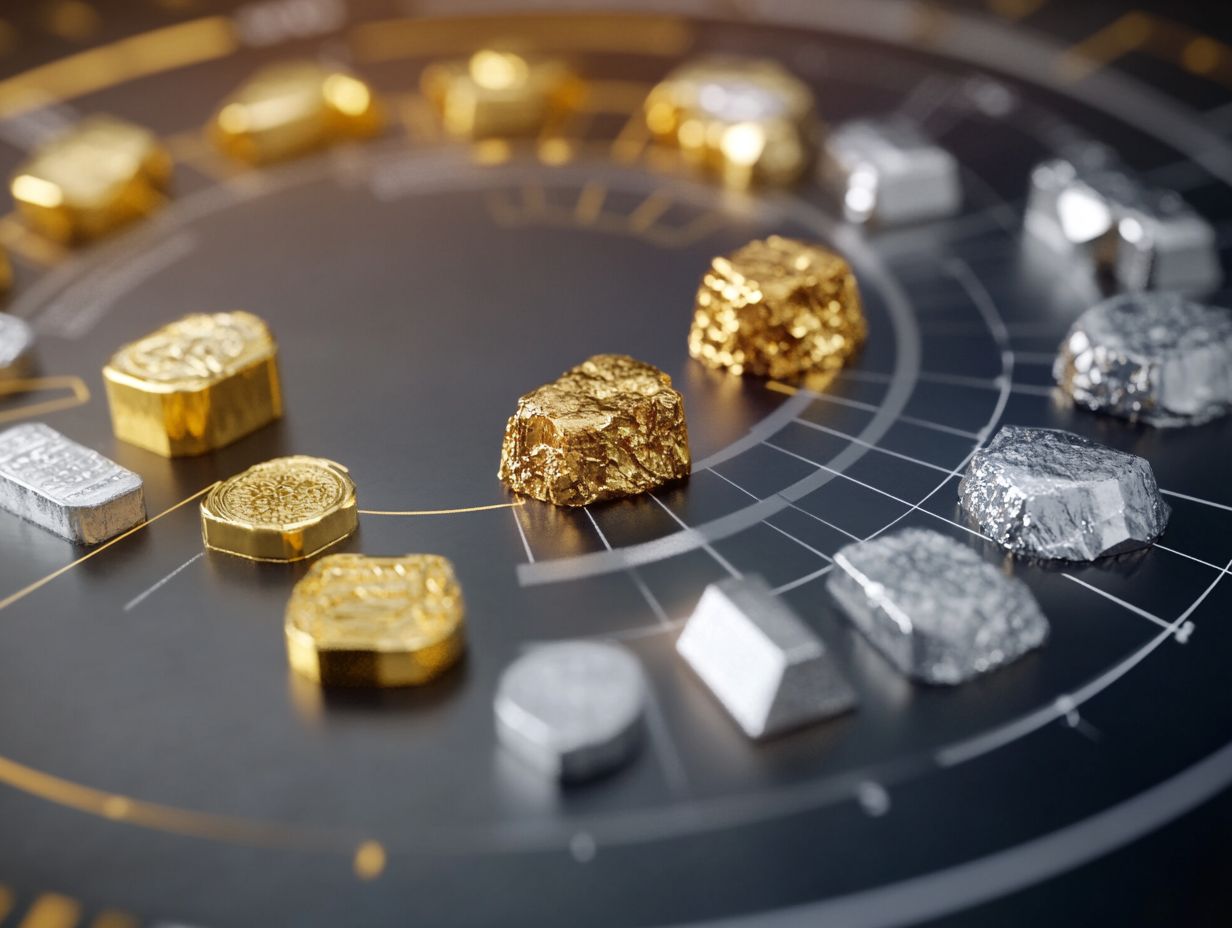
The intricate dance of supply and demand plays a pivotal role in shaping precious metal market cycles, with both industrial and jewelry demand significantly influencing price fluctuations.
In recent years, sectors such as renewable energy and electric vehicles have dramatically increased their demand for metals like silver and platinum, introducing new market pressures that intertwine with traditional jewelry demand.
As innovations continue to reshape various industries, the production of solar panels and batteries accelerates consumption rates, particularly for metals renowned for their conductive properties.
Cultural preferences and seasonal trends in jewelry can create variable spikes in demand. This makes it imperative for you to monitor these sectors and understand how they impact the broader cycles of precious metals in the market.
Investor Sentiment
Investor sentiment plays a pivotal role in shaping market cycles for gold and silver. This sentiment often influences your investment decisions and how you perceive the gold-silver ratio.
It can change rapidly in response to economic news, geopolitical events, and various external factors. For example, when inflation surges or global markets become uncertain, you may seek safer assets, which can drive up the prices of these precious metals.
The study of how people invest suggests that you, like many investors, may overreact or underreact to new information, resulting in cycles of fear and greed that distort market valuations.
Historical data reveals that during times of increased uncertainty, demand for gold and silver typically rises as investors turn to these metals as protective investments against potential economic downturns. This demand affects prices and investor behavior, creating a feedback loop that amplifies shifts in sentiment even further.
Identifying Market Cycles
Identifying market cycles requires careful examination of various indicators that signal trends in gold and silver prices.
By recognizing these cycles early, you can make informed, strategic decisions that optimize your investment portfolio.
This proactive approach enhances your chances of success and positions you advantageously in a fluctuating market.
Key Indicators to Look For
When identifying market cycles in precious metals, key indicators to keep an eye on include shifts in market sentiment, fluctuations in interest rates, and economic downturns that can impact prices. Take advantage of these indicators to make savvy investment choices!
By understanding these factors, you ll be better equipped to gauge potential price movements. For instance, historical data reveals that during times of economic uncertainty, precious metals often become the go-to investment, serving as a hedge against inflation.
Conversely, a rise in interest rates typically indicates a strengthening economy, which can lead to a dip in precious metal prices as investors gravitate toward equities.
Act now! Incorporate these indicators such as the Consumer Confidence Index or the yield curve into your strategies to position yourself advantageously for the cyclical nature of these markets, ensuring a more resilient portfolio whether conditions are rising or falling.
Strategies for Investing in Precious Metals
Effective strategies for investing in precious metals require a sophisticated blend of portfolio diversification, risk management, and targeted hedging techniques for gold and silver.
By gaining a deeper understanding of how these strategies align with market cycles, you can significantly enhance your investment outcomes.
How to Make the Most of Market Cycles
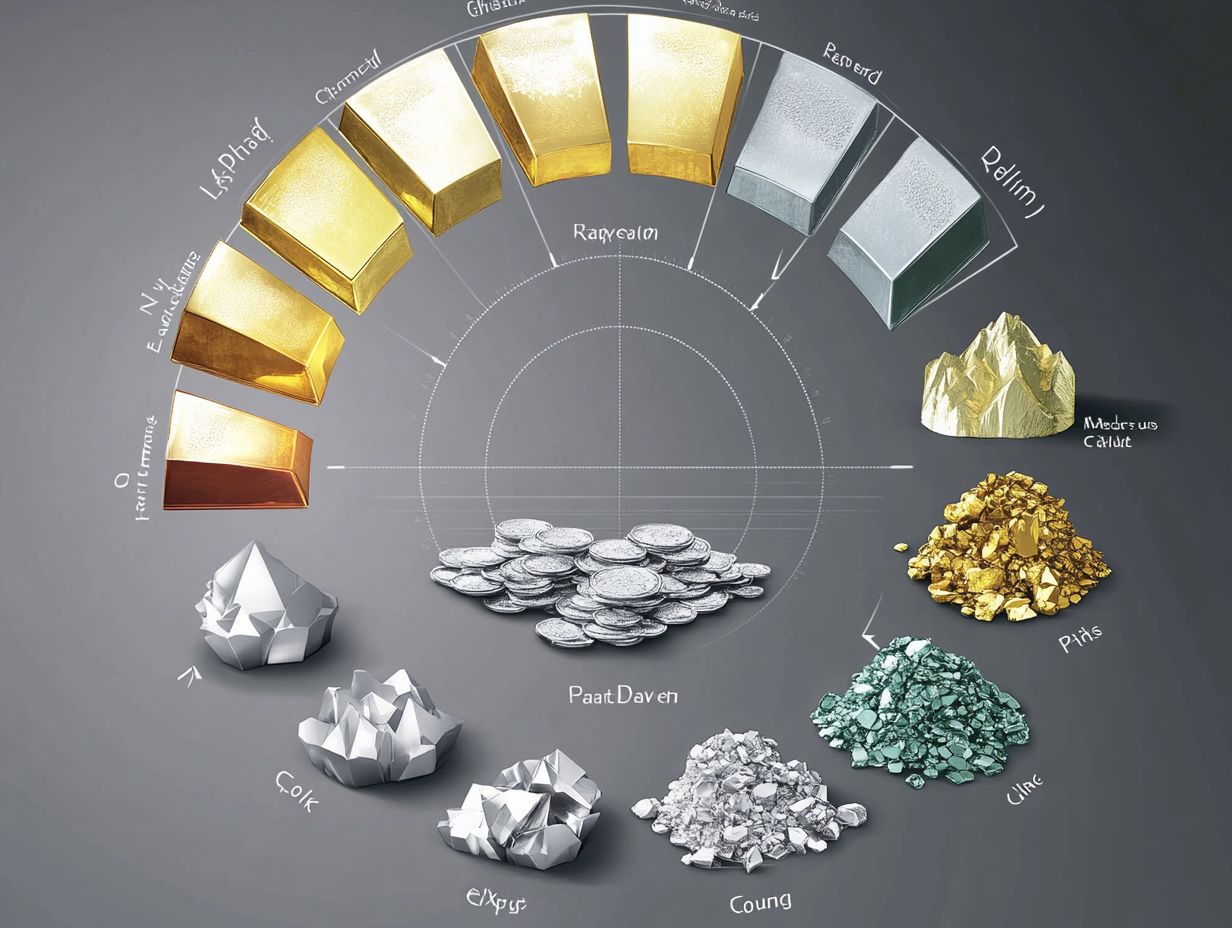
To truly capitalize on market cycles, you must align your investment decisions with the prevailing trends in gold and silver prices. This involves timing your purchases and sales based on market indicators and economic conditions.
Successful navigation of these markets requires a sharp eye for research and data analysis, enabling you to understand the cyclical nature of these precious metals. Grasping historical patterns can be incredibly beneficial. For instance, during economic downturns, gold frequently serves as a safe haven, while robust market recoveries tend to favor silver.
By examining case studies like the savvy investors who took advantage of lower prices during the 2008 financial crisis you can appreciate the distinct advantages of strategic timing. Utilizing tools such as technical analysis and staying informed about global economic news will empower you to make enlightened decisions that maximize your returns.
Long-term vs. Short-term Investing
Understanding the distinctions between long-term and short-term investing strategies in precious metals is essential for effectively navigating market cycles. Each approach presents its own advantages and risks, which can significantly influence your overall investment performance.
Long-term strategies typically involve holding assets like gold and silver for several years. This option allows you to capitalize on their potential appreciation over time. If you lean toward long-term investing, you’ll likely enjoy greater stability and find yourself less swayed by short-term market fluctuations.
On the other hand, short-term strategies are all about making quick trades to seize immediate price changes. This approach appeals to those looking for rapid gains, but it also exposes you to higher volatility and risk.
Choose the strategy that best fits your goals and risk tolerance, and watch your investments thrive!
Predicting Future Market Cycles
Predicting future market cycles for precious metals necessitates a blend of technical analysis, expert insights, and a sharp understanding of market indicators.
By harnessing these tools, you can more accurately anticipate price movements and fine-tune your strategies to align with market trends.
The Role of Technical Analysis
Technical analysis is essential for predicting market cycles for gold and silver, enabling you to identify potential price trends and reversal points. By diving into historical price data, you can make more informed decisions that align with your investment strategy.
You can utilize various charting techniques, such as candlestick formations and trend lines, to gain a clearer visualization of market movements. Indicators like the Relative Strength Index (RSI), which helps identify overbought or oversold conditions, and Moving Averages are invaluable tools for detecting shifts in momentum. Trading patterns like head and shoulders or double tops indicate upcoming reversals.
For example, during a bullish trend in gold prices, you might notice a moving average crossover, suggesting a prime entry point for a long position. Historical patterns reveal that recognizing a ‘cup and handle’ formation often precedes significant price increases, thereby boosting your confidence in predictions rooted in these analytical methods.
Expert Opinions and Forecasts
Expert opinions and forecasts are invaluable tools as you navigate the intricate market cycles of precious metals. These insights can significantly shape your investment strategies and give you a broader perspective on the ever-changing market dynamics.
Industry experts stress the importance of understanding historical trends to anticipate future movements. By analyzing patterns in market behavior, you can identify potential shifts that may impact your investment opportunities.
Analysts also highlight how macroeconomic factors like inflation rates and geopolitical tensions uniquely influence precious metals, reinforcing the necessity for you to stay well-informed.
By integrating these forecasts into your tailored investment plan, you enhance your agility in decision-making and position yourself to capitalize on emerging trends. This approach effectively hedges your risk while maximizing your returns in a volatile market environment.
Frequently Asked Questions
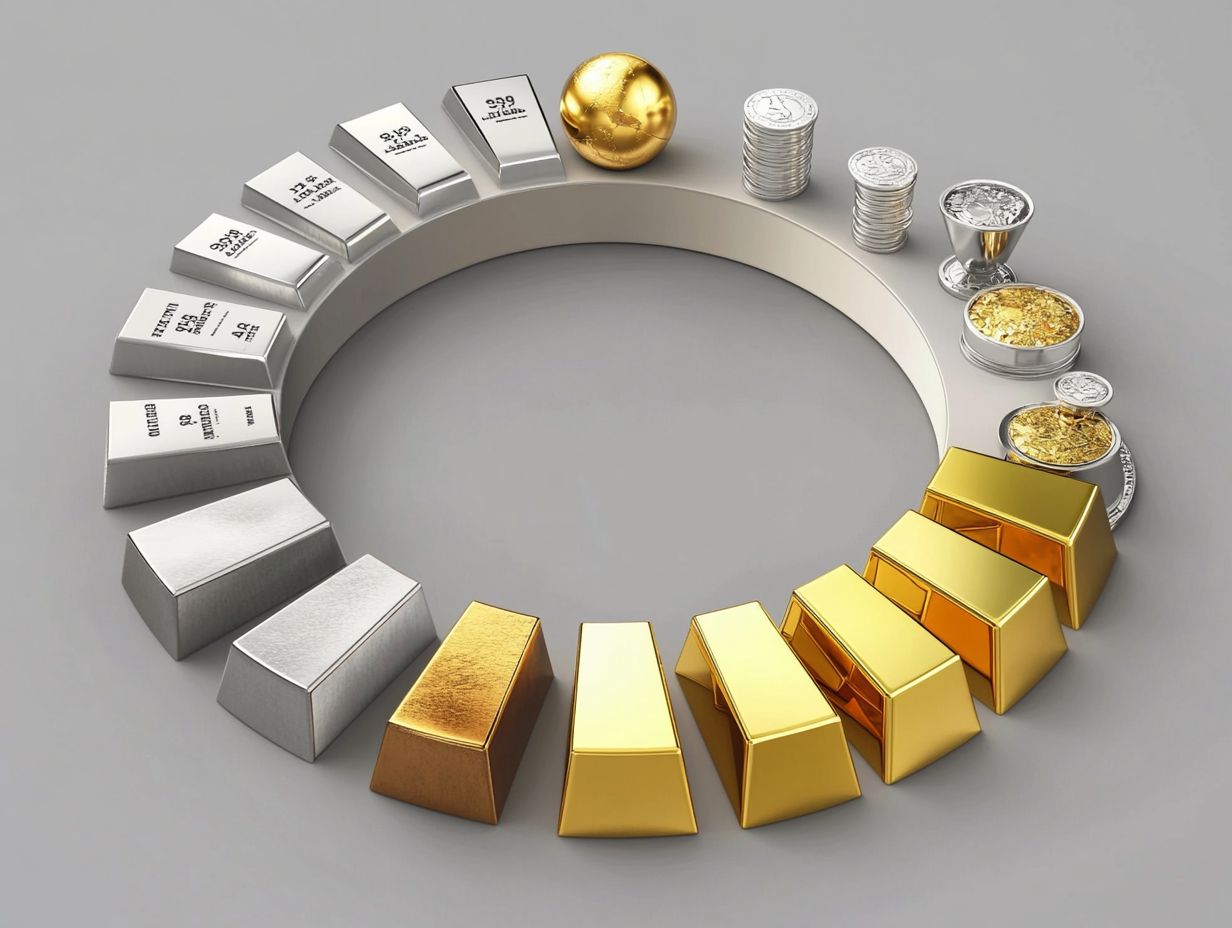
Curious about precious metal market cycles? Let s dive in!
Precious metal market cycles refer to the fluctuations in the value of precious metals, such as gold and silver, over time. These cycles are influenced by various economic, political, and social factors. They can significantly impact the prices of these metals.
How can understanding precious metal market cycles benefit me?
Understanding precious metal market cycles can help you make informed investment decisions. By being aware of the trends and patterns in these cycles, you can identify potential buying and selling opportunities. To deepen your knowledge, check out understanding the basics of precious metal futures. This knowledge can help you seize market opportunities and potentially boost your profits—don’t miss out!
What are the different stages of a precious metal market cycle?
A precious metal market cycle has four main stages: accumulation, markup, distribution, and markdown.
In the accumulation stage, prices are low. Investors start buying.
During the markup stage, prices go up as demand increases.
In the distribution stage, prices reach their peak, and investors begin selling.
Finally, in the markdown stage, prices go down as supply exceeds demand.
What factors influence precious metal market cycles?
Various factors can influence precious metal market cycles, including economic conditions, inflation, geopolitical events, and monetary policies. Additionally, supply and demand, investor sentiment, and global trends can also impact these cycles.
How long do precious metal market cycles typically last?
The duration of precious metal market cycles can vary and is difficult to predict. Some cycles may last for a few months, while others can span several years. The length of a cycle is influenced by the factors driving it and can change over time.
What can I do to stay updated on precious metal market cycles?
To stay updated on precious metal market cycles, regularly monitor market trends. Follow reputable financial news sources and seek guidance from experts in the field. Conducting thorough research is essential before making any investment decisions.


